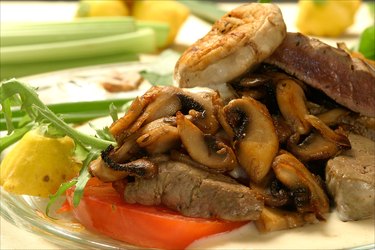
Any cut of beef is better when cooked properly, but few demonstrate the difference between skilled and unskilled preparation as starkly as liver. Beef liver stands out even among organ meats for its strong and distinctive flavor, which remains pleasant when handled carefully, but otherwise quickly turns bitter. An understanding of its qualities and a few basic cooking techniques are key to enjoying this inexpensive and highly nutritious cut.
Why It's Different
Video of the Day
Part of the problem is that liver is not made up of muscle, so it behaves differently from other meats. If you dice a steak and put it into your food processor, it makes a stiff paste that can be shaped into meatballs and similar dishes. Liver, on the other hand, disintegrates into a wet, pulpy slurry. This is because it's made up of individual cells held together by a delicate web of connective tissue, rather than sturdy, ropy strands of muscle fiber. Overcooking the liver causes its cells to shed their moisture, leaving it dry, leathery and somewhat grainy on the palate. Its sulfur-based flavor molecules, like those in cabbage, also become stronger and less pleasant with prolonged cooking.
Video of the Day
Doneness Matters
The final temperature of your liver has a lot to do with its palatability. Liver cooked to or past the well-done stage, at 160 degrees Fahrenheit, is likely to toughen and develop the strong, bitter flavors that repel so many diners. Cooked below a temperature of 140 F, liver's high concentration of iron-rich cells gives it an unpleasantly metallic flavor. Between those boundaries, at varying levels of pinkness, the liver will remain tender and moist. The U.S. Department of Agriculture recommends cooking all organ meats to 160 F to maximize food safety, so this must be an individual choice for each diner. The USDA also advises against rare steaks and soft-yolk eggs, which nevertheless remain popular because they're enjoyable that way.
Advance Preparation
You can mute the strong flavor of beef liver by soaking it ahead of time in lightly salted cold water for 30 minutes, or in milk or buttermilk for as long as overnight. Remove the liver from its liquid and blot it dry with clean paper towels before proceeding. Beef liver is typically sold sliced, because of its size, but the slices often contain portions of veins or tough membrane. Remove these with the tip of a sharp knife. Depending on your chosen preparation method, you might also opt to cut the liver into smaller pieces.
Cooking Methods
Pan-frying is a classic preparation method, long familiar to aficionados of diner food. Dredge the soaked liver in flour, shake off any excess, and sear it in a medium-hot pan until its surface is crisp and brown and the interior reaches your preferred level of doneness. Thick slices, of roughly 1/3 to 1/2 inch, are best for this technique. The browned-on juices and flour in your skillet can then be turned into gravy, by stirring in water or beef stock. European recipes often call for thin, bite-sized pieces of liver that can be quickly stir-fried with fresh herbs or other seasonings. Vintage cookbooks also offer numerous recipes for baked liver, smothered in gravy or sauce to help keep it moist and prevent overcooking.
Liven It Up
A number of other ingredients complement liver's bold flavor. Onions, either fried or caramelized, accent the liver with sweet and savory notes as well as providing moisture. The sweet smokiness of bacon and earthy notes of mushrooms are equally effective, either on their own or in combination with the onions. European recipes often include wine or other acidic ingredients, including wine vinegar and tomato sauces, or sweet ingredients such as figs. Liver is almost always one of the lowest cost options in your supermarket's meat case, so experimenting freely with different flavors won't break your grocery budget.